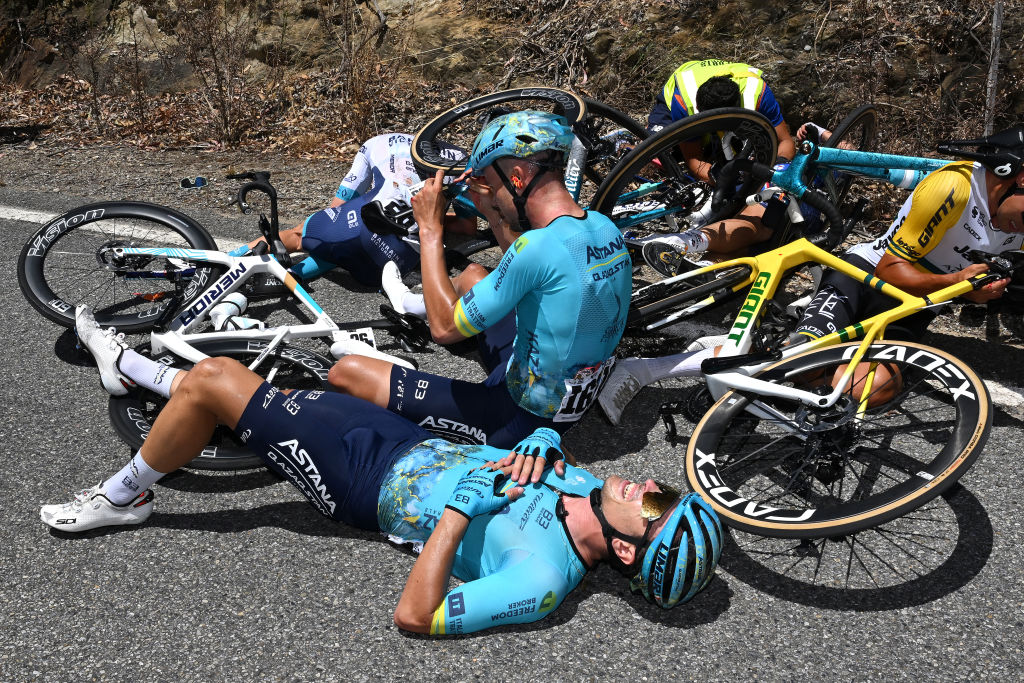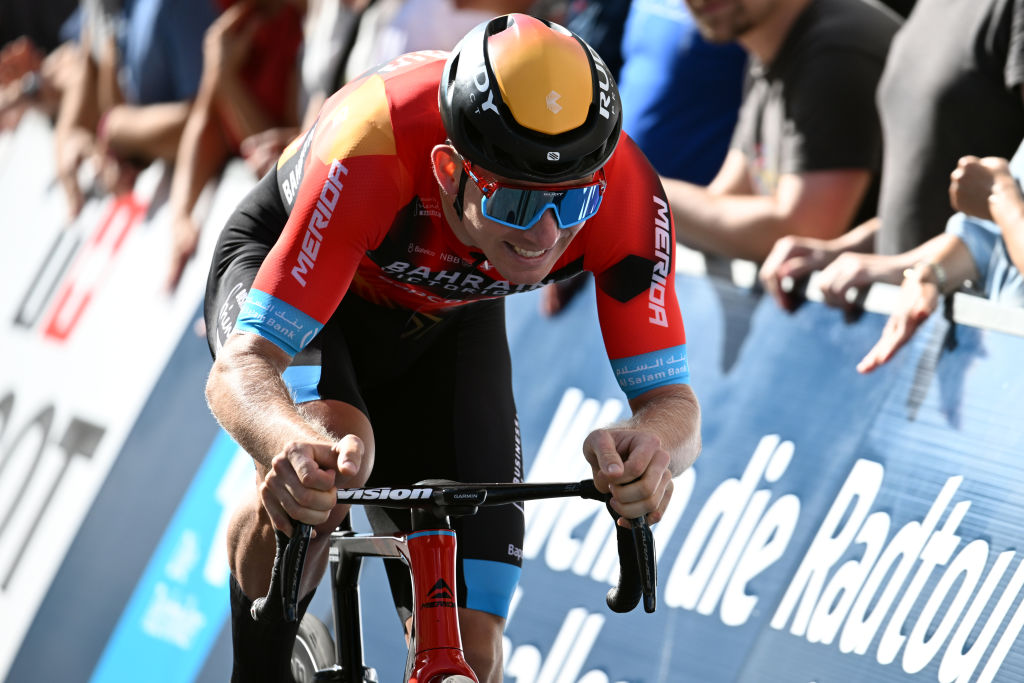
There had apparently been rush in the peloton before a descent down Gorge Rd, near the fast finish of stage 3 of the Tour Down Under when Cameron Scott came unstuck.
Details on how the crash happened were sketchy but according to one account the Bahrain Victorious pro was travelling at speed when he went over the top of a pile of riders in front of him.
Rudy Molard’s tour ended there. The Groupama-FDJ climber later posted a selfie from hospital on social media, his face, knuckles and shoulder badly lacerated.
Luke Plapp (Jayco-Alula) eventually pulled himself from the ground and pedalled slowly into Campbelltown, missing half the skin from his back that was red raw and exposed, his paper-thin green and gold lycra jersey in tatters.
Following UCI concussion protocols, Bahrain Victorious sports director Neil Stephens had asked Scott a specific set of questions when he pulled up in a team car at the crash site.
Luke Plapp out of Tour Down Under following stage 3 crash
Tour Down Under: Sam Welsford speeds to second win on stage 3
A long-awaited Tour Down Under return, crashes, genetic lotteries and the podium spot quandary - Jack Haig interview
Subscribe to Cyclingnews to gain unlimited access to the 2024 Tour Down Under
The Australian passed the simple, cycling-specific questions he was asked – like what stage of the race it was, what the name of the start town was, the finish town – so got back on his bike to complete the remaining 13-odd kilometres, albeit at a slow pace.
However, the next morning, before the start of stage 4, both he and Plapp had abandoned. Three Astana Qazaqstan riders involved in the same stack continued, despite walking gingerly around sign-on.
In a second standard assessment after stage 3, Bahrain Victorious team doctor Matthew Brown had determined Scott had whiplash and a mild concussion. His race was over.
“Later on, you sit the rider down and do what we call a SCAT test and that stands for Sport Concussion Assessment Tool. It’s used all around the world in different sports and basically, it’s the best thing available to test for concussion,” Brown told Cyclingnews at the start of stage 4.
“You test their memory, balance, co-ordination, you assess the symptoms that they have. And what we do at Bahrain, and what other teams will do as well - because the UCI have pushed this rule now - is at the start of the season we do one of these concussion tests on all our riders.
“So that if there is a crash, like there was with Cam yesterday, I can do that test in the hotel last night and then compare it to the one we did at the beginning of the season. We can look at his balance, memory and see if there is a significant difference to the beginning of the season when he was well,” Brown continued.
“But basically, when someone has had a high-impact head injury like that and they’ve got a headache, stiffness in their neck, they’re feeling sick and dizzy, the risk of starting a race is too high, and he ticked some of those boxes, you need to rest them completely.”
It wasn’t so long ago that you could have argued concussion was something that pro cycling didn’t seem to take overly seriously. The image of Chris Horner finishing a stage of the 2011 Tour de France questioning where he was and not even being able to recall crashing now lives on in infamy on YouTube.
Compared to other codes, such as the Australian Football League (AFL), which has a 12-day no-play policy in the event of a concussion diagnosis, hurried questions at the side of the road or after the stage to determine the likelihood of a concussion don’t seem wholly adequate. Not to mention that the sport is so mentally and physically demanding that halfway through a Grand Tour no one involved in the travelling circus - concussed or not - generally knows where they’ve come from, where they are going or what day it is.
However, Brown said concussion and the diagnosis and treatment of head knocks is something that the UCI has worked hard on since introducing a sports-related concussion protocol in 2020. And it’s clearly something that Bahrain Victorious takes seriously.
“We want to make sure we’re doing everything we can to reduce the risk to our athletes,” Brown said.
“The UCI have done a lot of work this year and we’ve been doing education sessions within the team, and the UCI are doing it as well, to make sure sports directors, coaches and anyone who could be first to get to a rider knows what question to ask in order to recognise serious head injuries at the side of the road.
“We all know they’re going at high speeds and the risk of head injuries are extremely high. So, it's really important everyone knows how to assess at the side of the road. That was done really well yesterday with Cameron.”
In a sport that is constantly moving, has no time-outs, no in-game substitutions, and is literally comprised of moving parts, the system is obviously not foolproof.

'If in doubt, sit them out'
Jack Haig believes the crash that took him out of title contention at the Giro d’Italia last year may have given him a concussion that went undiagnosed.
“I personally, the first thing I did, was I checked my helmet, to check if there was any damage there, because I didn’t feel 100 per cent right,” Haig said.
“And then when I saw there wasn’t any damage to my helmet, I thought maybe I’m not concussed. But you can get concussion without hitting your head, it’s just the movement of the brain inside the skull, so I don’t know. It’s super hard and it’s also a bit of a grey area about where on the spectrum on concussion you are. It’s not a clear cut, ‘You broke your elbow.’
The 30-year-old had no obvious physical head wounds from the crash but admits he didn’t feel right until after the race had finished.
“We are way more aware about it. We have a lot of concussion protocols now, there are documents inside the cars to make sure the directors are aware of it, so it’s getting better and better. But it’s a difficult sport to police it,” Haig said.
Policing concussion in cycling, Brown admitted, is tricky. The spectrum of a head trauma can range from unconscious to no immediate, visible signs of physical trauma. When you’re young and a potentially career-defining stage result is on the line the latter can be easily dismissed. But enough of them can lead, in later years, to far more sinister outcomes, like chronic traumatic encephalopathy (CTE).
Brown emphasises that the UCI does have return-to-competition protocols when it comes to concussion but admits they’re harder to enforce compared to other sports.
“One of the most difficult things in cycling is the initial assessment of concussion,” he said.
“We all know these high-profile cases now where athletes who have had repeated minor head traumas that were potentially not managed correctly could lead to CTE, which effectively is similar to dementia in older age.
“If you get to a rider who has had a crash, if it’s a severe head injury, it sounds awful to say, but they’ll be unconscious. And you know that person is going to hospital. And then sometimes you can bang your head and be absolutely fine, you can continue the race and carry on, no problem.
“Those two extremes of that spectrum are easy to manage. It’s the bit in the middle where they bang their head, they’re not quite right, they’ve got a little bit of a headache, a little bit dizzy - those are the ones we need to not miss, basically,” Brown continued.
“The bottom line is, if in doubt, sit them out. You want to get them out of the race because exertion, especially in a sport like cycling, puts them at risk of things like headaches."
"And actually, if you don’t manage these things properly, there’s a risk of getting chronic problems like headaches and things going forward - which you don’t want when they’re so young.”







